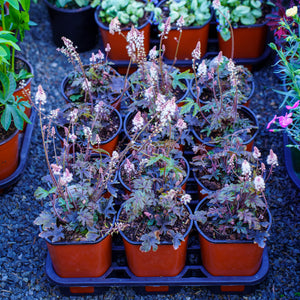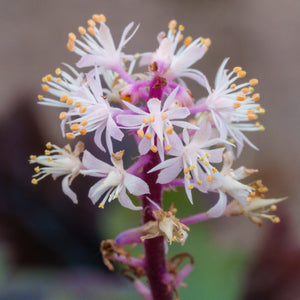The Tiarella Guide
Tiarella, commonly known as foamflower, is a charming woodland perennial celebrated for its frothy flower spikes and intricately lobed foliage. Often used in shaded gardens and naturalized settings, Tiarella adds soft texture and seasonal color to ground layers under trees or alongside hostas and ferns. Its delicate, airy blooms rise above attractive foliage, which often features dramatic markings and seasonal coloration. Low-maintenance and reliable, Tiarella is a favorite for gardeners seeking beauty in the shade.
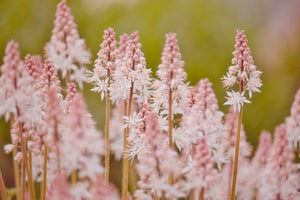
About
Tiarella is native to North America and thrives in woodland environments. It is a member of the Saxifragaceae family and includes both clump-forming and running species. Tiarella cordifolia, the most common species, produces a spreading mat of foliage with bottlebrush-like flowers in spring. Cultivars such as 'Spring Symphony' and 'Sugar and Spice' are admired for their refined leaf patterns and compact habits, while selections like 'Running Tapestry' and 'Brandywine' offer strong groundcover performance through stoloniferous spread.
Foliage can be deeply cut or rounded and frequently features striking veins or marbling, as seen in 'Fingerpaint', 'Angel Wings', and 'Timbuktu'. Many varieties provide multi-season interest, with foliage taking on bronze, burgundy, or maroon tones in cooler months. Foamflowers are also valued for their pollinator-friendly blooms, which attract native bees and hoverflies.

PLANTING
Tiarella is easy to establish in woodland gardens, shaded borders, and as groundcover in dappled light:
- USDA Hardiness Zones: Typically hardy in Zones 4–9, with good cold tolerance.
- Soil: Prefers moist, humus-rich, well-draining soil with a slightly acidic to neutral pH.
- Sunlight: Best grown in partial to full shade. Tolerates morning sun but should be protected from intense afternoon exposure.
- Watering: Consistent moisture is key, especially during establishment. Avoid letting the soil dry out completely.
- Spacing: Space clumping varieties 12–15 inches apart; allow 15–18 inches for running types.
- Planting Time: Best planted in spring or early fall to allow roots to settle before seasonal extremes.
Prepare the soil with compost or leaf mold to improve drainage and nutrient availability. Water deeply after planting and apply a thin mulch layer to retain moisture and moderate soil temperature.
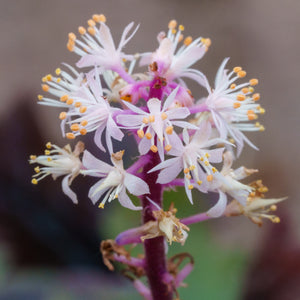
CARE
Tiarella is an easy-care perennial that benefits from thoughtful maintenance:
- Watering: Keep soil evenly moist throughout the growing season. During droughts or heat waves, supplemental watering is essential.
- Fertilizing: A light application of balanced fertilizer or compost in early spring supports foliage and flower development.
- Pruning: Remove faded flower spikes to tidy the plant and encourage foliage focus. Clean up spent leaves in fall or early spring.
- Dividing: Clump-forming types can be divided every 3–4 years in early spring. Runners may be trimmed or transplanted as needed.
- Pests & Diseases: Tiarella is largely pest-free but may be affected by slugs or mildew in overly damp or poorly ventilated conditions.
Choose disease-resistant cultivars and ensure adequate air circulation to prevent fungal issues. Running types may need containment in small gardens.
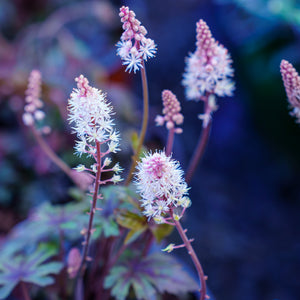
HOW TO USE
Tiarella is a versatile perennial that works well in many shaded or naturalized designs:
- Woodland Gardens: Plant among ferns, hellebores, and hostas for a soft, textural understory in shaded beds.
- Groundcover Plantings: Running varieties like 'Running Tapestry' are ideal for covering soil beneath trees or larger shrubs.
- Shaded Borders: Use cultivars like 'Elizabeth Oliver' or 'Cutting Edge' for patterned foliage and compact form in front-of-border groupings.
- Pollinator Gardens: Though not a major nectar source, foamflower blooms are visited by bees and early-season insects.
- Containers & Shady Courtyards: Clump-forming selections such as 'Sylvan Lace' and 'Pink Skyrocket' bring refinement to potted arrangements.
Tiarella pairs beautifully with Pulmonaria, Brunnera, Heuchera, Epimedium, and Carex for a layered, deer-resistant, low-maintenance shade planting.
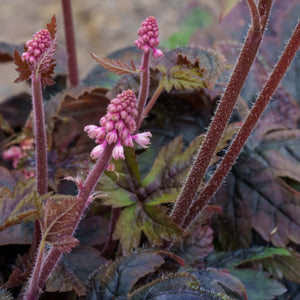
Common Questions
- Do deer eat Tiarella? Tiarella is generally deer-resistant due to its slightly bitter foliage.
- Does Tiarella spread? Clump-forming varieties stay in place, while others like Tiarella cordifolia 'Running Tapestry' spread gently via stolons.
- How to grow Tiarella? Plant in part to full shade, keep soil moist and enriched with compost, and avoid excess sun.
- Is Tiarella invasive? No, Tiarella is not considered invasive. Spreading forms expand moderately and are easy to manage.
- Is Tiarella poisonous to dogs? There is no evidence suggesting Tiarella is toxic to dogs.
- Is Tiarella poisonous to cats? Tiarella is not listed as toxic to cats and is generally considered pet-safe.
- How to propagate Tiarella? Divide clumps in spring or fall. Runners can be gently separated and replanted.
- When to plant Tiarella? Spring or fall planting is ideal for strong root development and minimal transplant stress.
- Do hummingbirds like Tiarella? While not a primary food source, foamflower blooms may attract hummingbirds, especially when planted near other nectar-rich species.
Conclusion
Tiarella brings texture, color, and early-season interest to shaded gardens, offering a refined alternative to more common groundcovers. With options ranging from compact, ornamental clumps to modestly spreading forms, foamflower fits effortlessly into woodland designs, native plantings, and under-canopy beds. It’s a dependable, low-maintenance plant that brings subtle charm to shaded spaces and supports a biodiverse landscape.
The Tiarella Collection
Sold Out
Sold Out


